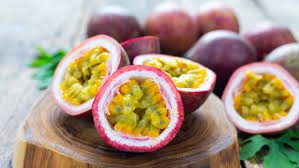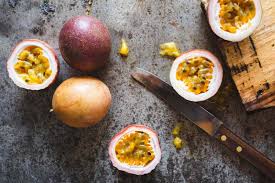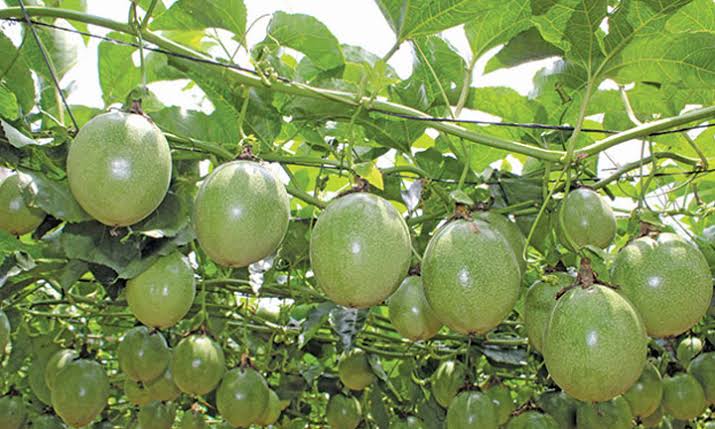Passion fruits scientifically known as Passiflora edulis are amazing fruits that come from a vine. These fruits are round and small, but don’t be fooled by their size—they are bursting with flavor. The outer skin of a passion fruit is tough, but inside, you’ll find a juicy, pulpy goodness that is both sweet and tangy.
These fruits are known for their unique taste that combines sweetness and a hint of tartness. The vibrant colors of their wrinkled outer skin, ranging from deep purple to yellow, make passion fruits stand out in a crowd.
One remarkable thing about passion fruits is the seeds. Inside the pulpy interior, numerous small, black seeds are scattered. These seeds are edible, adding a delightful crunch to the overall experience. Some people even enjoy scooping the seeds with a spoon and savoring them along with the juicy pulp.
Passion fruits are not just delicious; they are also packed with nutrients. They are a great source of vitamin C, which helps keep our immune system strong. Additionally, they contain dietary fiber, which is good for digestion and helps keep our stomach happy.
One exciting way to enjoy passion fruits is by making refreshing drinks. You can blend the pulp with water, add a bit of sugar, and voila—passion fruit juice! It’s a fantastic way to cool down on a hot day. Some people also use passion fruit as a topping for desserts or mix it into yogurt for a tasty treat.
These fruits are not only tasty but also versatile. Chefs often use passion fruit in both sweet and savory dishes. The unique flavor profile of passion fruit adds a special touch to salads, sauces, and even cocktails.
Growing passion fruit at home is also possible, and many people find it rewarding. The vines are hardy and can adapt to various climates. With a little care and attention, you could have your own supply of fresh passion fruits right in your backyard.
In addition, passion fruits are more than just delicious; they are a tropical delight that brings joy to our taste buds. Whether eaten on their own, blended into a refreshing drink, or used in cooking, these fruits offer a burst of flavor that is both satisfying and nutritious. So, the next time you come across passion fruits, don’t hesitate to indulge in their unique and delightful taste.
Read Also: 12 Poultry Eggs Fascinating Facts You Must Know About
History Passion Fruits (Passiflora edulis)

The history of passion fruits is like a journey through tropical lands and discovery. These unique fruits are native to South America, particularly in regions like Brazil and Paraguay. The exact origin is a bit mysterious, but it is believed that indigenous people in these areas were the first to enjoy the flavorful goodness of passion fruits.
When Spanish explorers arrived in South America, they encountered these exotic fruits and were captivated by their taste. The explorers were so impressed that they brought passion fruits back to Europe, introducing them to a whole new part of the world. The fruit’s name, “passion fruit,” is thought to come from the flower’s resemblance to elements of the Passion of Christ, as observed by Spanish missionaries.
From Europe, passion fruits made their way to other tropical regions across the globe. They adapted well to different climates, finding homes in places like Africa, Asia, and Australia. The vines flourished, and the fruits became popular in various cuisines.
In the 19th century, passion fruit cultivation expanded, especially in places with suitable climates like Hawaii and New Zealand. These regions embraced passion fruits, and the fruits became integral parts of local agriculture and diets.
Today, passion fruits are enjoyed worldwide. They are not just a tropical delight; they have become a global sensation. You can find them in markets, grocery stores, and even growing in home gardens. People appreciate their unique taste and use them in a variety of dishes, from juices and desserts to savory recipes.
The history of passion fruits is a tale of exploration, cultivation, and the spread of a delightful fruit across continents. From their humble beginnings in South America to becoming a beloved ingredient in diverse cuisines, passion fruits have truly made their mark on the world.
Nutritional Value of Passion Fruits (Passiflora edulis)
Passion fruits are not just delicious; they also pack a nutritional punch. These tropical fruits are a rich source of essential nutrients that contribute to a healthy diet.
1. Vitamin C: Passion fruits are loaded with vitamin C, which is vital for a strong immune system. This vitamin also helps the body absorb iron and promotes healthy skin.
2. Dietary Fiber: The pulp of passion fruits contains a good amount of dietary fiber. Fiber is important for digestive health, aiding in regular bowel movements and promoting a feeling of fullness.
3. Antioxidants: Passion fruits are rich in antioxidants, including carotenoids and polyphenols. Antioxidants help protect the body’s cells from damage caused by free radicals, contributing to overall health.
4. Vitamin A: Passion fruits contain vitamin A, essential for maintaining healthy skin, vision, and a robust immune system.
5. Vitamin B-complex: These fruits provide various B vitamins, including B2 (riboflavin) and B3 (niacin), which play roles in energy metabolism and overall cellular function.
6. Minerals: Passion fruits contain minerals like iron, phosphorus, and potassium. Iron is important for preventing anemia, while potassium supports heart health and helps regulate blood pressure.
7. Low in Calories: Passion fruits are relatively low in calories, making them a nutritious and guilt-free snack option.
8. Healthy Fats: The seeds of passion fruits contain healthy fats, including omega-3 and omega-6 fatty acids, which are beneficial for heart health.
Incorporating passion fruits into your diet can be a tasty way to boost your intake of essential nutrients. Whether eaten fresh, added to salads, blended into juices, or used in desserts, these fruits offer a delightful combination of flavor and health benefits.
Read Also: Importance of Amino Acids in Poultry Nutrition
Health Benefits of Passion Fruits (Passiflora edulis)

Passion Fruit Health Benefits:
1. Rich in Antioxidants: Passion fruits are loaded with antioxidants, which help neutralize harmful free radicals in the body. Antioxidants contribute to overall health and may play a role in reducing the risk of chronic diseases.
2. Boosts Immune System: The high vitamin C content in passion fruits supports a strong immune system. Adequate vitamin C intake is crucial for the body’s defense against infections and illnesses.
3. Promotes Digestive Health: The dietary fiber in passion fruits aids digestion and helps prevent constipation. Fiber is essential for a healthy digestive system and can contribute to weight management.
4. Heart Health: Passion fruits contain potassium, a mineral that supports heart health by helping regulate blood pressure. Additionally, the fiber and antioxidants in these fruits may contribute to cardiovascular well-being.
5. Eye Health: The presence of vitamin A in passion fruits is beneficial for maintaining healthy vision. Vitamin A supports the proper functioning of the eyes and helps prevent age-related macular degeneration.
6. Aids in Anemia Prevention: Passion fruits contain iron, which is essential for preventing and treating iron-deficiency anemia. Iron plays a crucial role in the production of red blood cells and oxygen transport in the body.
7. May Have Anti-Inflammatory Properties: Some studies suggest that passion fruits may have anti-inflammatory effects, potentially benefiting conditions related to inflammation in the body.
8. Supports Skin Health: The combination of vitamin C and antioxidants in passion fruits contributes to skin health. These nutrients help combat oxidative stress, which can contribute to premature aging.
9. Weight Management: The fiber content in passion fruits can help with weight management by promoting a feeling of fullness and reducing overeating.
10. Nutrient Diversity: Passion fruits provide a variety of essential nutrients, including vitamins, minerals, and healthy fats, contributing to overall nutritional balance in the diet.
Incorporating passion fruits into a well-rounded diet can be a tasty way to enjoy these health benefits. Whether eaten on their own, added to dishes, or blended into beverages, passion fruits offer a nutritious and flavorful addition to a healthy lifestyle.
How to Grow Passion Fruits (Passiflora edulis)

Growing Passion Fruits:
1. Climate and Soil: Passion fruits thrive in warm tropical or subtropical climates. They prefer well-drained, sandy-loam soil with a slightly acidic to neutral pH. Ensure good drainage to prevent waterlogging.
2. Choose the Right Variety: Select a passion fruit variety suitable for your climate. Common varieties include Passiflora edulis (purple passion fruit) and Passiflora ligularis (yellow passion fruit).
3. Planting: Plant passion fruit seeds or seedlings in a location with full sun exposure. Space the plants at least 10 feet apart to allow for proper growth and air circulation. Planting during the warmer months is ideal.
4. Support Structures: Passion fruit vines need support as they grow. Install trellises, fences, or other support structures to help the vines climb and spread. Make sure the supports are sturdy enough to bear the weight of the mature vines.
5. Watering: Passion fruits require regular watering, especially during dry periods. However, they don’t like waterlogged soil, so ensure proper drainage. Water deeply, allowing the soil to dry slightly between waterings.
6. Fertilization: Fertilize passion fruit plants with a balanced fertilizer during the growing season. Follow the recommended application rates on the fertilizer package. Avoid excessive nitrogen, as it can lead to vigorous vegetative growth with fewer fruits.
7. Pruning: Prune the vines regularly to encourage air circulation and control their growth. Remove dead or diseased branches and trim to shape the plant. Pruning also helps in managing pests.
8. Mulching: Apply a layer of organic mulch around the base of the plant to retain soil moisture, suppress weeds, and regulate soil temperature.
9. Pest and Disease Management: Keep an eye out for pests like aphids and scale insects. Treat infestations promptly with insecticidal soap or neem oil. Passion fruits can be susceptible to diseases like fusarium wilt; ensure good sanitation practices and consider disease-resistant varieties.
10. Harvesting: Passion fruits typically start bearing fruit within 6-9 months. Harvest when the fruits are fully colored, slightly wrinkled, and have fallen off the vine or come off easily when gently twisted. Ripe passion fruits will have a sweet aroma.
Growing passion fruits requires patience and attention, but the reward is the satisfaction of harvesting your own fresh and flavorful fruits.
Read Also: Hydroponics Guide 101: All You Need to Know About it
